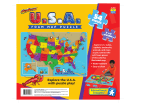
The ambient temperature is highlighted on the SeaScope
thermometer. If a temperature is clearly highlighted in green, that
is the temperature. If more than one temperature is highlighted,
the exact temperature is in between the highlighted numbers.
Using SeaScope with the Telescope Attached
To attach the telescope to the SeaScope, press its large end into
thearedyellowcupontheendoftheblacktube(seeFigure1).
Press gently but firmly until you feel it fit into place. Submerge the
large end of the SeaScope in the water and then look through the
telescope’s eye cup. Slide out the smaller tube to focus.
Note: If you are too close to your subject, it may still appear blurry.
Try viewing your subject from at least one foot away.
Attaching and Removing the Aqualite™ Flashlight
To attach your Aqualite™ Flashlight to the SeaScope, insert the
rear of the flashlight into the back portion of the light holder
(seeFigure1).Slidethelightbackuntilthefrontofthelightis
aligned with the holder. Press the front down until it snaps into
place. To remove the light, lift up on the front end of the light until
it pops out of the holder.
Caution: SeaScope floats. Hold your SeaScope firmly when
placing it in water. If you let go, it will pop out of the water and
may cause injury.
Adjustable telescope focuses
from 4 ft. (1.22 m) to infinity.
Press onto SeaScope for
magnified underwater viewing.
Rotate head to
turn on light.
Thermometer
tTo inser flashlight:
1. Press the rear of the
flashlight into the holder.
Pliable yellow retaining ring
can be removed for cleaning.
Tube closes for ease in carrying.
2. When belt loops align with
light holder, snap flashlight
into place.
To see distant objects, such as a mountaintop, push the small
tube into the bigger tube as you look through the eyepiece until
you see the object come into focus. To get a steady view, rest
the telescope on something solid, such as the back of a chair.
Remember: NEVER look directly at the sun!
IN THE WATER
Use your SeaScope to explore the awesome underwater world.
Explore a pond, stream, lake, tide pool, or even a swimming pool.
You can stay dry while you explore underwater by submerging
the end of your SeaScope in the water while you stand on land or
on a boat. Make sure an adult is with you. Do not explore alone!
Your SeaScope will work in water with or without the telescope.
Without the telescope, you get a wider field of view. The water
will still naturally magnify the image. If you choose to attach the
telescope(seebelow),youwillgetadditionalmagnicationfor
a more detailed view of your specimen. Try observing both ways
to see the dierence. Since the image is magnified, it is hard to
knowitssize.UsetheruleronyourSeaScopetondouthow
big your specimens actually are. Record your findings. Also, note
the temperature on the SeaScope thermometer and record it.
Dierentlivingthingsthriveatdierenttemperatures.
Figure 1
5252 Guide.indd 2 2/12/10 3:34:39 PM





